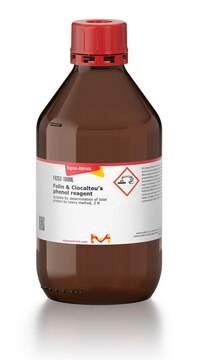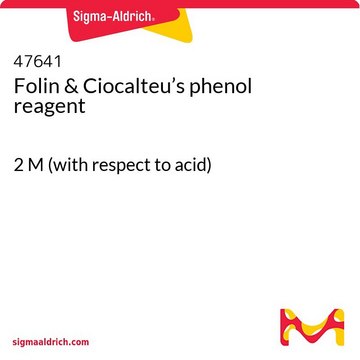8.42649
Gallic acid
anhydrous, for synthesis
Synonim(y):
Gallic acid
Zaloguj sięWyświetlanie cen organizacyjnych i kontraktowych
About This Item
Wzór empiryczny (zapis Hilla):
C7H6O5
Numer CAS:
Masa cząsteczkowa:
170.12
Numer MDL:
Kod UNSPSC:
12352106
Numer indeksu EC:
205-749-9
NACRES:
NA.22
Polecane produkty
klasa czystości
anhydrous
Poziom jakości
Próba
≥98.0% (acidimetric)
temp. przechowywania
2-30°C
InChI
1S/C7H6O5/c8-4-1-3(7(11)12)2-5(9)6(4)10/h1-2,8-10H,(H,11,12)
Klucz InChI
LNTHITQWFMADLM-UHFFFAOYSA-N
Opis ogólny
(anhydrous) for synthesis
Zastosowanie
- Gallic acid in tumor-targeted therapy: A study described the use of gallic acid-loaded HFZIF-8 nanoparticles for enhanced tumor-targeted delivery and thermal-catalytic therapy, showcasing potential applications in cancer treatment strategies (Yang et al., 2024).
- Gallic acid in industrial processes: Research highlighted the integration of gallic acid within porous sponges for efficient dye adsorption and emulsion separation, indicating its utility in environmental and industrial applications (Yan et al., 2024).
- Gallic acid in extraction processes: The use of gallic acid was explored in the ultrasound-assisted extraction of bioactive pigments from Spirulina platensis, employing natural deep eutectic solvents to enhance extraction efficiency and safety (Martins et al., 2023).
- Gallic acid in self-healing materials: A novel study developed a self-healing hydrogel using gallic acid and carboxymethyl cellulose, triggered by Fe(3+) coordination cross-linking, demonstrating innovative applications in materials science (Yang et al., 2024).
Komentarz do analizy
Assay (acidimetric): ≥ 98.0 %
Identity (IR): passes test
Identity (IR): passes test
Ta strona może zawierać tekst przetłumaczony maszynowo.
Hasło ostrzegawcze
Warning
Zwroty wskazujące rodzaj zagrożenia
Zwroty wskazujące środki ostrożności
Klasyfikacja zagrożeń
Eye Irrit. 2 - Skin Irrit. 2 - STOT SE 3
Organy docelowe
Respiratory system
Kod klasy składowania
11 - Combustible Solids
Klasa zagrożenia wodnego (WGK)
WGK 1
Temperatura zapłonu (°F)
Not applicable
Temperatura zapłonu (°C)
Not applicable
Certyfikaty analizy (CoA)
Poszukaj Certyfikaty analizy (CoA), wpisując numer partii/serii produktów. Numery serii i partii można znaleźć na etykiecie produktu po słowach „seria” lub „partia”.
Masz już ten produkt?
Dokumenty związane z niedawno zakupionymi produktami zostały zamieszczone w Bibliotece dokumentów.
Klienci oglądali również te produkty
Nasz zespół naukowców ma doświadczenie we wszystkich obszarach badań, w tym w naukach przyrodniczych, materiałoznawstwie, syntezie chemicznej, chromatografii, analityce i wielu innych dziedzinach.
Skontaktuj się z zespołem ds. pomocy technicznej








